白光LED(WLED)作为白炽灯、荧光灯、节能灯后的新一代照明光源,以其寿命长,耗电低,发光效率高和环保等优点受到研究者们的广泛关注[1-2]。目前,WLED的主要制备途径有两条:近紫外LED芯片组合红绿蓝三基色荧光粉和蓝色LED芯片组合黄色荧光粉YAG∶Ce3+,前者由于荧光粉在近紫外,发光效率不高,且使用的红色荧光粉发光强度较低、基质稳定性差等,严重影响了WLED的性能[3-5]。后者由于缺乏红光部分,因此色温偏高,显色指数较低。并且,在高电流下,蓝光光谱的发光强度要比黄光增加的快,随着电流的改变会引起光谱的不匹配,进而导致色温的改变和显色指数进一步降低[6]。高色温、低显指等问题对WLED的实际应用存在限制。因此,获取一种能够有效发出红光的发光材料,对促进白光LED的发展具有重大意义[4-8]。
在众多稀土离子中,Eu3+由于其4f-4f的电子构型与5D0→7F2的跃迁,在红光区域有着强烈的发射,并且在近紫外和蓝光范围内有较强的吸收峰,因此被广泛应用于红色荧光粉的掺杂离子[9-13]。
钼酸盐具有较为独特的晶体结构和物理性质,使其在各领域均存在广泛的应用价值,如荧光粉的基质材料、抗菌材料、激发施主材料等[11]。[MoO4]2-在近紫外具有宽而强的电荷转移吸收带,这是由于[MoO4]2-中O2-向Mo6+的电荷转移造成的,可以有效地吸收蓝紫光发射出的能量,并将能量传递给基质中掺杂的稀土离子使之发光,因此钼酸盐被认为是非常好的发光基质材料[11, 13]。
近年来,具有白钨矿结构的钼酸盐受到广泛关注,如M5Re(MoO4)4(M=Li、Na、K;Re=Y、La等),即是一种较好的材料,在掺杂Eu3+后会呈现出强烈的红光发射,并且此类材料具有合成温度低和较好的物理、化学稳定性等特性。
目前,针对Eu3+掺杂Na5Y(MoO4)4红色荧光粉特性的研究报道比较少。本文将采用高温固相法合成新型Na5Y1-x(MoO4)4∶xEu3+红色荧光粉,并对其物相结构、发光特性和热稳定性等性质进行分析探讨,探索其在白光LED照明领域应用的潜在可行性。
1 实验本研究采用高温固相法制备Na5Y1-x(MoO4)4∶xEu3+ (x=0~0.9)红色荧光粉,样品所需原料分别为Na2CO3(99.9%)、MoO3(99.9%)、Eu2O3(99.99%)、Y2O3(99.9%)。根据摩尔配比计算样品原料相应的质量后进行称量,将称量后的原料放入玛瑙研钵中研磨20 min,以保证原料之间混合充分,再将研磨后的粉末从玛瑙研钵中转移到刚玉坩埚中,置于马弗炉中在550 ℃煅烧4 h,然后将温度缓慢降至室温。最后,将样品重新研磨10~15 min,使其重新成为粉末状用于测试。
采用Panalytical X’Pert Pro X射线粉末衍射仪分析该样品的物相结构,使用PerkinElmer Lambada650s紫外可见分光光度计测试样品的漫反射谱;使用爱丁堡FLS980稳态-瞬态光谱仪进行样品的激发发射和寿命的测试。采用EX-1000荧光粉激发光谱与热猝灭分析系统(杭州远方光电信息股份有限公司)测试样品的光谱和色坐标。
2 结果与讨论 2.1 物相分析Na5Y(MoO4)4的晶体结构属于四方晶系,I41/a(88)空间群,晶格常数为a=1.137 4 nm,b=1.137 4 nm,c=1.144 0 nm,晶胞体积V=1.48 nm3。其中:Na+与6个O2-结合形成六配位(CN=6)的八面体构型;Y3+与8个O2-结合形成八配位(CN=8)的十二面体构型;Mo6+与4个O2-结合形成四配位(CN=4)的四面体构型,如图 1所示。

|
图 1 Na5Y(MoO4)4晶体结构示意图 Fig.1 Crystal structure diagram of Na5Y(MoO4)4 |
图 2为Na5Y1-x(MoO4)4∶xEu3+(x=0~0.9)的XRD谱图。从图 2可知,该样品各浓度的衍射峰的位置与标准卡JCPDS 82-2368相匹配,无杂峰产生,表明所合成的荧光粉为纯相。其中,Na+的离子半径r=0.102 nm,Y3+的离子半径r=0.09 nm,Mo6+的离子半径r=0.059 nm,由于掺杂的Eu3+的离子半径(r=0.095 nm,CN=6;r=1.07 nm,CN=8)与Y3+的离子半径(r=0.09 nm,CN=6;r=1.02 nm,CN=8)最为接近,因此,在相同的配位环境下Eu3+会优先取代Y3+的位置。掺杂前后样品的各衍射峰位置无明显变化,表明Eu3+掺杂对Na5Y(MoO4)4的晶体结构未产生显著的改变。

|
图 2 Na5Y1-x(MoO4)4∶xEu3+(x=0~0.9)样品的XRD谱图 Fig.2 XRD patterns of Na5Y1-x(MoO4)4∶xEu3+(x=0~0.9) samples |
图 3为Na5Y0.3(MoO4)4∶0.7Eu3+荧光粉的激发光谱(蓝色,左侧区域)和发射光谱(红色,右侧区域),当荧光发射波长为614 nm时,由左图可见, 在230~ 338 nm的宽带归属于Eu-O电荷迁移带(CTB),中心波长为284 nm。在350~493 nm区间,存在因Eu3+的电子4f-4f特征跃迁所形成的5个激发峰,分别位于362 nm(7F0→5D4),382 nm (7F0→5L7),393 nm(7F0→5L6),416 nm(7F0→5D3)和465 nm(7F0→5D2)处,其中位于393 nm位置的激发峰最强。右图为393 nm波长激发下的发射光谱,谱图中有Eu3+的4个特征发射峰,分别为591 nm(5D0→7F1)、614 nm(5D0→7F2)、653 nm(5D0→7F3)、700 nm(5D0→7F4)。614 nm处是Eu3+对晶体场变化敏感的电偶极跃迁,590 nm处为Eu3+对晶体场变化不敏感的磁偶极跃迁。当磁偶极跃迁比电偶极跃迁发光强度高时,Eu3+占据反演对称位,反之,Eu3+占据非反演对称位[10]。

|
图 3 Na5Y0.3(MoO4)4∶0.7Eu3+荧光粉的激发光谱和发射光谱 Fig.3 Excitation and emission spectra of Na5Y0.3(MoO4)4∶0.7Eu3+ phosphor |
本研究中,614 nm处的荧光发射强度更高,因此在样品中Eu3+占据非反演对称位,发射谱是以电偶极跃迁为主导的红色发光。
图 4是不同浓度Na5Y1-x(MoO4)4∶xEu3+(x=0.3~0.9)荧光粉的发射谱和积分后的荧光强度与掺杂浓度之间的关系曲线。
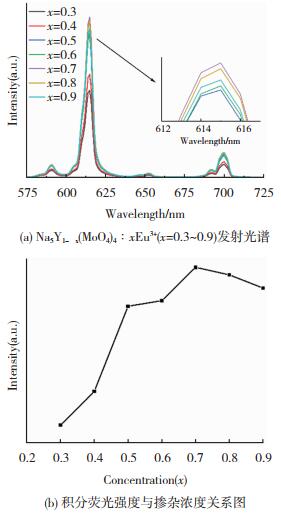
|
图 4 发射光谱与掺杂浓度对应的荧光强度积分曲线图 Fig.4 Emission spectra and integral curves of fluorescence intensity corresponding to doping concentrations: (a) emission spectra of Na5Y1-x(MoO4)4∶xEu3+(x=0.3~0.9); (b) correlation between integral of fluorescence intensity and doping concentrations |
从图 4(a)可知,随着Eu3+掺杂浓度的增加,荧光强度在变化,但发射峰的位置未发生改变,这也表明随Eu3+的掺入,样品的晶体结构未产生较大变化。从图 4(b)可知,荧光强度在x=0.3~0.7范围内随浓度的增加呈现上升趋势,但在x=0.7~0.9范围呈下降趋势,这是由于随着掺杂浓度的增加,发光中心Eu3+之间的距离小于临界值,发生了浓度猝灭现象。依据Blasse公式,临界距离Rc可以表示为[14]
| $ {R_{\rm{c}}} = 2{\left( {\frac{{3V}}{{4{\rm{ \mathsf{ π} }}{X_{\rm{c}}}N}}} \right)^{\frac{1}{3}}} $ | (1) |
式中:Xc为Eu3+最佳掺杂浓度;N代表单位晶胞的阳离子数;V代表晶胞体积。由前文结构数据可知,V=1.48 nm3,Xc=0.7,N=4,计算得到样品的临界距离Rc=1.0 nm。当Rc大于0.5 nm时,浓度猝灭归因于电多极之间的相互作用,当Rc小于0.5 nm时,浓度猝灭是由离子间能量传递作用导致[15]。计算结果表明,导致浓度猝灭的原因是电多极的相互作用,根据Dexter理论公式[16],
| $ \frac{I}{x}=K\left[1+\beta(x)^{\frac{Q}{3}}\right]^{-1} $ | (2) |
式中:K、β为常数;x和I分别代表掺杂浓度和发光强度;Q值对应相互作用的类型。当Q值为3,6,8,10时,分别对应相互作用类型中的离子间的相互作用、电偶极-电偶极、电偶极-电四极以及电四极-电四极。
图 5为样品的发射强度与浓度的关系曲线,斜率的数值为1.93,可知Q值接近6。因此,说明造成浓度猝灭的原因是电偶极-电偶极相互作用[17]。
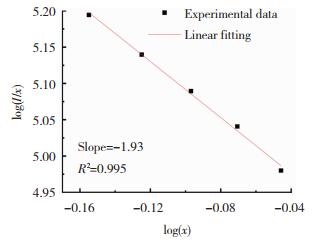
|
图 5 Na5Y1-x(MoO4)4∶xEu3+中Eu3+的log (I/x)和log(x)的关系曲线 Fig.5 Correlation between log(I/x) and log(x) of Na5Y1-x(MoO4)4∶xEu3+ phosphors |
图 6是在393 nm激发下Na5Y0.3(MoO4)4∶0.7Eu3+在不同温度时的发射谱,可以看到,随着温度的升高样品的荧光强度减弱,在423 K时其室温发射强度仍保持在81%以上,说明Na5Y0.3(MoO4)4∶0.7Eu3+具有良好的热稳定性。
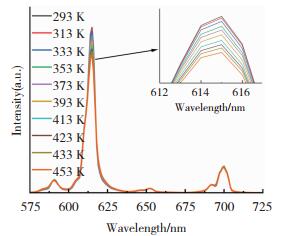
|
图 6 不同温度下Na5Y0.3(MoO4)4∶0.7Eu3+的发射谱 Fig.6 Emission spectra of Na5Y0.3(MoO4)4∶0.7Eu3+ at different temperatures |
图 7为样品ln(I0/I-1)与1/KBT关系曲线图,由修正的Arrhenius公式[18]可知,
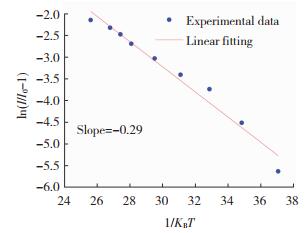
|
图 7 ln(I0/I-1)与1/KBT关系曲线图 Fig.7 Relation between ln(I0/I-1) and 1/KBT |
| $ \ln \left(\frac{I_0}{I}-1\right)=\ln (A)-\frac{E_{\mathrm{a}}}{K_{\mathrm{B}} T} $ | (3) |
式中:A为常数;KB为玻尔兹曼常数。计算可得活化能Ea=0.29 eV。对比于其他的荧光粉,如KBaY(MoO4)3∶Eu3+(0.261 eV)[19]、NaYGeO4∶Eu3+(0.131 eV)[20]和SrBi2TeO7∶Eu3+(0.28 eV)[21]等,Na5Y0.3(MoO4)4∶0.7Eu3+样品活化能Ea的数值略高。目前对于Eu3+在基质中的温度猝灭研究原因,大都倾向于Eu3+之间的交叉弛豫[19],理论上,活化能越大,热猝灭程度越低,热稳定性越好。因此,Na5Y0.3(MoO4)4∶0.7Eu3+样品具有较好的热稳定性。
2.4 漫反射图 8为Na5Y0.3(MoO4)4∶0.7Eu3+的漫反射谱,在402、451和522 nm上有Eu3+的吸收峰,对应于7F0→5D3、7F0→5D2、7F0→5D1跃迁。为探究稀土掺杂对带隙Eg的影响,通过式(4)对Na5Y0.3(MoO4)4∶0.7Eu3+的带隙Eg进行评估。
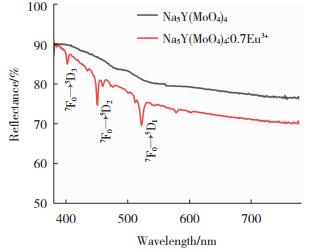
|
图 8 Na5Y(MoO4)4和Na5Y0.3(MoO4)4∶0.7Eu3+的漫反射谱 Fig.8 Diffuse reflectance spectra of Na5Y(MoO4)4 and Na5Y0.3(MoO4)4∶0.7Eu3+ |
| $ (\alpha h \nu)^n=c \nu\left(h \nu-E_{\mathrm{g}}\right) $ | (4) |
式中:α为吸收系数;v为入射光频率;h为普朗克常数;c为常数;n值可以取2和1/2来对应直接和间接跃迁。吸收系数可由Kubelka-Munk[22]公式计算。
| $ F(R)=\frac{(1-R)^2}{2 R}=\frac{k}{s} $ | (5) |
式中:R为漫反射率;s为散射系数;k与s成比例。Na5Y0.3(MoO4)4∶0.7Eu3+为直接跃迁的宽带隙材料[23],因此n值为2。通过拟合[F(R)hv]2与hv关系曲线如图 9,可计算Na5Y0.3(MoO4)4∶0.7Eu3+的带隙为2.793 eV。

|
图 9 [F(R)hv]2与hv关系曲线 Fig.9 Shows the relationship curve of [F(R)hv]2 and hv |
通过CIE1931表征不同浓度的样品所对应的色坐标,结果如图 10所示,可以看到样品均位于红光区域,随着掺杂浓度的增加色坐标并未发生明显的漂移。表 1为用色坐标、色温公式[24]计算得到的相应色温表。
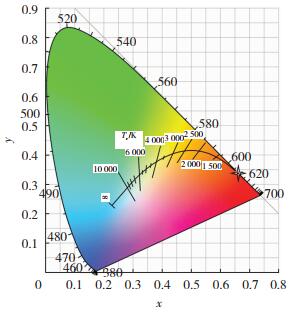
|
图 10 Na5Y1-x(MoO4)4∶xEu3+色坐标 Fig.10 Color coordinate of Na5Y1-x(MoO4)4∶xEu3+ |
| 表 1 Na5Y1-x(MoO4)4∶xEu3+的色坐标和色温表 Table 1 Color coordinate and color temperature of Na5Y1-x(MoO4)4∶xEu3+ |
| $ n=\frac{X-0.332}{Y-0.186} $ | (6) |
| $ \text { CCT }=-449 n^3+3\, 525 n^2-6\, 823 n+5\, 520.33 $ | (7) |
图 11为不同浓度Na5Y1-x(MoO4)4∶xEu3+(x=0.1~0.9)荧光粉在465 nm波长激发下的发射谱图,表 2为该波长下的色温和色坐标。
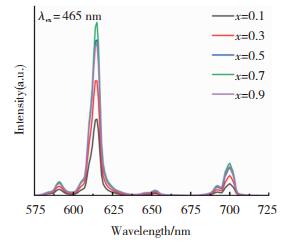
|
图 11 Na5Y1-x(MoO4)4∶xEu3+(x=0.1~0.9)发射光谱图 Fig.11 Emission spectra of Na5Y1-x(MoO4)4∶xEu3+(x=0.1~0.9) |
| 表 2 Na5Y1-x(MoO4)4∶xEu3+的色坐标和色温表 Table 2 Color coordinate and color temperature of Na5Y1-x(MoO4)4∶xEu3+ |
如表 2所示,在465 nm波长激发下, 该样品不同浓度的色坐标都位于红色区域,并未发生明显漂移,均具有较低的色温。
2.6 寿命衰减图 12为Na5Y1-x(MoO4)4∶xEu3+(x=0.3、0.5、0.7、0.9)在393 nm波长激发和614 nm波长检测下的荧光衰减曲线。采用单指数对数据进行拟合,见式(8)[25]。

|
图 12 Na5Y(MoO4)4∶xEu3+荧光寿命曲线 Fig.12 Fluorescence lifetime decay curves of Na5Y(MoO4)4∶xEu3+ |
| $ I(t)=I_0 \exp \left(\frac{-t}{\tau}\right) $ | (8) |
式中:I(t)和I0分别对应于时间t和0时的发光强度;τ为荧光寿命。
由式(8)计算可得Na5Y1-x(MoO4)4∶xEu3+(x=0.3、0.5、0.7、0.9)的寿命分别为τ=0.653、0.667、0.677、0.654 ms。由此可以发现,Na5Y1-x(MoO4)4∶xEu3+ (x=0.3、0.5、0.7、0.9)的荧光寿命,在浓度猝灭前随着掺杂浓度的升高而变长,可能是由于发光中心的非辐射跃迁降低所致[26],具体原因尚需进一步的研究。达到最佳浓度x=0.7后开始出现浓度猝灭,荧光寿命随着掺杂浓度的升高而变短,应是由于Eu3+离子间的能量转移,相互作用增强等导致[27]。
3 结论本文通过高温固相法成功制备了一系列Na5Y1-x(MoO4)4∶xEu3+(x=0.1~0.9)荧光粉,该系列样品可以在393 nm波长的激发下,于614 nm处发出强烈的红光,研究表明,样品Na5Y1-x(MoO4)4∶xEu3+的最佳掺杂浓度为x=0.7时,浓度猝灭机理为电偶极-电偶极之间的相互作用。并且Na5Y1-x(MoO4)4∶xEu3+样品在423 K高温下仍保持有其室温发射强度的81%以上,其荧光寿命在浓度猝灭前随着掺杂浓度的升高而变长,猝灭后随掺杂浓度的升高而变短,该样品不同浓度的CIE色坐标均位于红色区域,无明显漂移。综上所述,Eu3+掺杂Na5Y(MoO4)4荧光粉在白光LED领域具有潜在的应用前景。
| [1] |
于汀, 高明燕, 宋岩, 等. Dy3+, Eu3+共掺的LiGd (MoO4)2单一相荧光粉的合成, 发光及能量传递[J]. 无机化学学报, 2018, 34(5): 857-863. YU Ting, GAO Mingyan, SONG Yan, et al. Synthesis luminescence and energy transfer of Dy3+ Eu3+ co-doped LiGd (MoO4)2 single phase phosphor[J]. Chinese Journal of Inorganic Chemistry, 2018, 34(5): 857-863. DOI:10.11862/CJIC.2018.116 |
| [2] |
姜营营, 刘桂霞, 王进贤, 等. 白色荧光粉NaGd(MoO4)2∶Dy3+, Eu3+的水热合成及发光性能[J]. 高等学校化学学报, 2013, 34(4): 794-799. JIANG Yingying, LIU Guixia, WANG Jinxian, et al. Hydrothermal synthesis and luminescence properties of white phosphor NaGd(MoO4)2∶Dy3+, Eu3+[J]. Chemical Journal of Chinese Universities, 2013, 34(4): 794-799. DOI:10.7503/cjcu20120662 |
| [3] |
卢杨, 史忠祥, 王晶, 等. MgAl2O4∶Eu3+荧光粉的制备及其光谱特性[J]. 中国有色金属学报, 2022, 32(1): 100-108. LU Yang, SHI Zhongxiang, WANG Jing, et al. Preparation and spectral properties of MgAl2O4∶Eu3+ phosphor[J]. The Chinese Journal of Nonferrous Metals, 2022, 32(1): 100-108. DOI:10.11817/j.ysxb.1004.0609.2022-36673 |
| [4] |
翟永清, 李金航, 李璇, 等. 白光LED用红色发光材料CaLa2(MoO4)4∶Eu3+的微波辅助溶胶-凝胶法合成及发光特性[J]. 硅酸盐学报, 2015, 43(7): 952-958. ZHAI Yongqing, LI Jinhang, LI Xuan, et al. Microwave-assisted sol-gel synthesis and luminescence properties of white LED using red luminescent material CaLa2(MoO4)4∶Eu3+[J]. Journal of the Chinese Ceramic Society, 2015, 43(7): 952-958. DOI:10.14062/j.issn.0454-5648.2015.07.16 |
| [5] |
叶信宇, 罗洋, 刘松彬, 等. LiGd(WyMo(1-y))2O(8-x/2)Fx: Eu3+红色荧光粉的制备和发光特性[J]. 发光学报, 2016(10): 1203-1212. YE Xinyu, LUO Yang, LIU Songbin, et al. Preparation and luminescence properties of LiGd(WyMo(1-y))2O(8-x/2) Fx∶Eu3+ red phosphor[J]. Chinese Journal of Luminescence, 2016(10): 1203-1212. DOI:10.3788/fgxb20163710.1203 |
| [6] |
谢安. 白光LED用钼酸盐红色荧光粉的制备及发光性能研究[D]. 武汉: 中国地质大学, 2010. XIE An. Preparation and luminescence properties of molybdate red phosphor for white LED[D]. Wuhan: China University of Geosciences, 2010. |
| [7] |
关丽, 魏伟, 刘超, 等. 红色荧光粉LiGd(MoO4)2∶Sm3+的制备与性能[J]. 硅酸盐学报, 2013, 41(1): 62-65. GUAN Li, WEI Wei, LIU Chao, et al. Preparation and properties of red phosphor LiGd(MoO4)2∶Sm3+[J]. Journal of the Chinese Ceramic Society, 2013, 41(1): 62-65. DOI:10.7521/j.issn.0454-5648.2013.01.13 |
| [8] |
周琦, 周恒为, 蒋小康. 近紫外激发Gd2ZnTiO6∶Eu3+, Li+红色荧光粉的制备及荧光性能[J]. 人工晶体学报, 2021, 50(12): 2269. ZHOU Qi, ZHOU Hengwei, JIANG Xiaokang. Preparation and fluorescence properties of Gd2ZnTiO6∶Eu3+, Li+ red phosphor excited by near UV[J]. Journal of Synthetic Crystals, 2021, 50(12): 2269. DOI:10.3969/j.issn.1000-985X.2021.12.010 |
| [9] |
田少华. 近紫外基白光LEDs用NaY (MoO4)2∶Eu3+材料的发光特性[J]. 光电子·激光, 2015, 26(10): 1942-1946. TIAN Shaohua. Luminescence properties of NaY(MoO4)2∶Eu3+ materials for near-UV based white LEDs[J]. Journal of Optoelectronics·Laser, 2015, 26(10): 1942-1946. DOI:10.16136/j.joel.2015.10.0457 |
| [10] |
吴冬妮, 崔瑞瑞, 龚新勇, 等. 新型红色荧光粉NaLa0.7(MoO4)(2-x)(WO4)x∶0.3Eu3+的制备及发光性质研究[J]. 发光学报, 2016(3): 274-279. WU Dongni, CUI Ruirui, GONG Xinyong, et al. Preparation and luminescence properties of a new red phosphor NaLa0.7(MoO4)2-x(WO4)x∶0.3Eu3+[J]. Chinese Journal of Luminescence, 2016(3): 274-279. DOI:10.3788/fgxb20163703.0274 |
| [11] |
罗朝莲, 明俊宇, 王春伟, 等. 铝酸钙基稀土荧光粉CaAl4O7∶Eu3+的制备及热稳定性研究[J]. 材料科学与工艺, 2022, 30(2): 43-50. LUO Chaolian, MING Junyu, WANG Chunwei, et al. Preparation and thermal stability of calcium aluminate rare earth phosphor CaAl4O7∶Eu3+[J]. Materials Science and Technology, 2022, 30(2): 43-50. DOI:10.11951/j.issn.1005-0299.20210306 |
| [12] |
XIAO Jiangguo, ZHANG Wentao, WANG Teshen, et al. Photoluminescence enhancement in a Na5Y(MoO4)4∶Dy3+ white-emitting phosphor by partial replacement of MoO42- with WO42- or VO43-[J]. Ceramics International, 2021, 47(9): 12028-12037. DOI:10.1016/j.ceramint.2021.01.046 |
| [13] |
徐晶, 闫景辉, 韩钰婷, 等. NaLa(MoO4)2∶Eu3+/Tb3+/Tm3+材料的合成, 发光及能量传递[J]. 光谱学与光谱分析, 2015, 35(10): 2712-2717. XU Jing, YAN Jinghui, HAN Yuting, et al. Synthetic luminescence and energy transfer of NaLa(MoO4)2∶Eu3+/Tb3+/Tm3+ materials[J]. Spectroscopy and Spectral Analysis, 2015, 35(10): 2712-2717. DOI:10.3964/j.issn.1000-0593(2015)10-2712-06 |
| [14] |
ZHANG Yang, GONG Weitao, NING Guiling. Novel red-emitting LiGd(WO4)2∶Eu3+ phosphor with high thermal stability and high color purity for application in white light-emitting diodes[J]. New Journal of Chemistry, 2016, 40(12): 10136-10143. DOI:10.1039/C6NJ02734B |
| [15] |
XIONG Feibin, CHEN Hao, et al. Photoluminescence characteristics of Sm3+-doped LnBWO6 (Ln= La, Gd and Y) as new orange-red phosphors[J]. Journal of Luminescence, 2019, 209: 89-94. DOI:10.1016/j.jlumin.2019.01.034 |
| [16] |
DENG Huajuan, ZHAO Ze, WANG Jing, et al. Photoluminescence properties of a new orange-red emitting Sm3+-doped Y2Mo4O15 phosphor[J]. Journal of Solid State Chemistry, 2015, 228: 110-116. DOI:10.1016/j.jssc.2015.04.023 |
| [17] |
XIONG Feibin, XIE L C, YANG Weibin, et al. SmxY1-xSr2SbO6double-perovskite phosphor: high thermal stability orange-emitting materials for warm WLEDs[J]. Applied Physics A, 2021, 127(10): 1-8. DOI:10.1007/s00339-021-04898-8 |
| [18] |
SUN Qi, WANG Shaoying, DEVAKUMAR Balaji, et al. Double perovskite Ca2LuTaO6∶Eu3+red-emitting phosphors: synthesis, structure and photoluminescence characteristics[J]. Journal of Alloys and Compounds, 2019, 804: 230-236. DOI:10.1016/j.jallcom.2019.06.260 |
| [19] |
宋明君, 赵旺, 王林同, 等. KBaY(MoO4)3∶Eu3+红色荧光粉的制备及发光性能研究[J]. 功能材料, 2018, 49(5): 5109-5114. SONG Mingjun, ZHAO Wang, WANG Lintong, et al. Synthesis and luminescent characterization of KBaY(MoO4)3∶Eu3+ red phosphor[J]. Journal of Functional Materials, 2018, 49(5): 5109-5114. DOI:10.3969/j.issn.1001-9731.2018.05.019 |
| [20] |
HAN Bing, CHEN Yawei, LIU Beibei, et al. Solid state synthesis and luminescence properties of Eu3+ doped NaYGeO4 phosphors[J]. Optik, 2021, 242: 167177. DOI:10.1016/j.ijleo.2021.167177 |
| [21] |
GAO Zhiwen, XUE Na, JEONG Jung Hyun, et al. SrBi2TeO7∶Eu3+: A novel blue-light excitable red-emitting phosphor for solid-state lighting[J]. Materials Research Bulletin, 2017, 95: 497-502. DOI:10.1016/j.materresbull.2017.08.002 |
| [22] |
CAO Guang, RABENBERG L K, NUNN C M, et al. Formation of quantum-size semiconductor particles in a layered metal phosphonate host lattice[J]. Chem Mater, 1991, 3(1): 149-156. DOI:10.1021/cm00013a032 |
| [23] |
BOLEK P, ZELER J, BRITES C D S, et al. Ga-modified YAG: Pr3+ dual-mode tunable luminescencethe rmometers[J]. Chemical Engineering Journal, 2021, 421: 129764. DOI:10.1016/j.cej.2021.129764 |
| [24] |
DILLIP G R, DHOBLE S J, RAJU B D P. Luminescence properties of Na3SrB5O10∶Dy3+plate-like microstructures for solid state lighting applications[J]. Optical Materials, 2013, 35(12): 2261-2266. DOI:10.1016/j.optmat.2013.06.012 |
| [25] |
GUO Chongfeng, XU Yan, DING Xu, et al. Blue-emitting phosphor M2B5O9Cl∶Eu2+ (MSr, Ca) for white LEDs[J]. Journal of Alloys & Compounds, 2011, 509(4): L38-L41. DOI:10.1016/j.jallcom.2010.10.032 |
| [26] |
YANG Nan, LI Junhao, ZHANG Ziwang, et al. Delayed concentration quenching of luminescence caused by Eu3+-induced phase transition in LaSc3(BO3)4[J]. Chemistry of Materials, 2020, 32(16): 6958-6967. DOI:10.1021/acs.chemmater.0c02203 |
| [27] |
GEORGE A, GOPI S, SREEJA E, et al. Host sensitized tunable luminescence of single phase white light emitting Ca2Sb2O7∶Eu3+ phosphors[J]. Journal of Materials Science: Materials in Electronics, 2020, 31(1): 423-434. DOI:10.1007/s10854-019-02545-w |
 2023, Vol. 31
2023, Vol. 31


